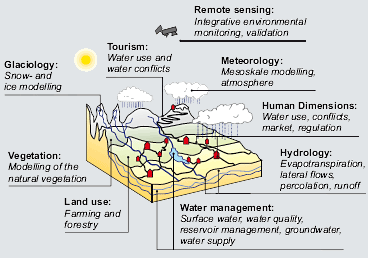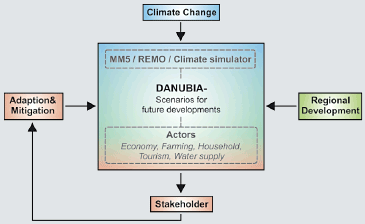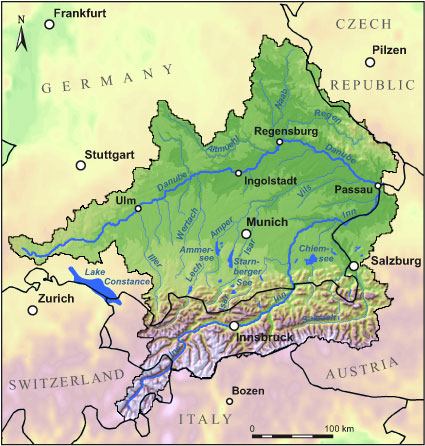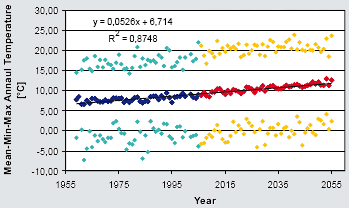|
|
 |
|
|
|
||
Integrative Techniques, Scenarios and Strategies for
the Future of Water in the Upper Danube Basin
GLOWA-Danube: Impact of Global Change on the Upper Danube
Global Climate Change will increasingly have regional impacts on the water resources. More frequent floods, low flows and droughts, the retreat of glaciers and of snow cover in the Alps as well as changes of the natural and agrarian vegetation particularly in the Upper Danube watershed will be likely consequences of Climate Change. They will influence strongly the future development of the region. In order to facilitate the most effective planning of future investments for decades (e.g. in energy management, farming, tourism, industry), an intensive examination of the regional consequences of Climate Change is necessary.

Aspects of integration in GLOWA-Danube
GLOWA-Danube is a research and development program focusing on the comprehensive analysis of the future of water resources of the Upper Danube. In GLOWA-Danube the impact of Climate Change of a broad range of sectors is investigated. Furthermore the project identifies and simulates strategies for adaptation to and mitigation of the consequences of Climate Change and tests their effectiveness. In GLOWA-Danube a team of researchers from different natural and socio-economic science disciplines work closely together in an interdisciplinary, university-based competence network since 2001.
Aim of GLOWA-Danube
The aim of GLOWA-Danube is to investigate with different scenarios the impact of change in climate, population and land use on the water resources of the Upper Danube and to develop and evaluate regional adaptation strategies. For this purpose the decision support system DANUBIA was successfully set up within the first and second project stage (2001-2006).

Timetable of the 3. project phase
DANUBIA – an integrative decision support system
DANUBIA is a coupled simulation model. It includes for the first time model components for natural science as well as socio-economic processes and their interactions. With the intension of being predictive DANUBIA uses results of regional climate models for predictions on Climate Change. Physical and physiological components describe natural processes (hydrology, hydro-geology, plant physiology, yield, and glaciology). For the simulation in the included sectors (farming, economy, water supply companies, private households and tourism) DANUBIA uses deep multi-actors models which represent the decisions of the involved actors based on the structure of societies, their framework as well as their interests. All components of DANUBIA run parallel on an inexpensive LINUX-cluster.
DANUBIA was carefully and successfully validated with comprehensive data sets of the years 1970-2005 and is now available in the third stage of the project for common use for project researchers and stakeholder.
DANUBIA will be made available as "Open Source" at the end of the third project stage in
2010 and will particularly serve decision makers from policy, economy, and administration as tool
for a foresighted planning of water resources against the background of Global Change.

Model of the scenario-based decision support system DANUBIA
Investigation area: The Upper Danube
DANUBIA is applied to the watershed of the Upper Danube. The Upper Danube with its more than 10 million inhabitants and an area of 77.000 km2 is one of the largest and most important alpine watersheds in Europe. With its strong relief and the altitudinal gradient of up to 3.600 m, the Upper Danube is particularly vulnerable to Climate Change. These conditions also lead to a remarkably broad range of influencing factors on the water resources. The watershed includes glaciers as well as temperate lowlands, which are intensively used by agriculture. The Upper Danube in addition is characterised by a complex and intensive use of the water resources for hydropower, farming (possibly future irrigation) and tourism (e.g. snow cannons). The watershed of the Upper Danube therefore combines in an exemplary way a lot of water use problems of Central Europe.

Investigation area: The Upper Danube
The future of the water at the Upper Danube
Scenario runs with DANUBIA are based on the findings of the IPCC and use results of regional climate models as well as statistical ensemble approaches for the estimation of the future regional Climate Change in the Upper Danube watershed. The analyses show that the average air temperature at the Upper Danube has already increased by approx. 1.5 °C in the last 30 years. The IPCC-A1B scenario expects a further intense Global Warming in the next 50 years.

The temperature increase at the Upper Danube: past and future
First results of scenario ensembles with DANUBIA already show that droughts in summer will broaden and that the low flow discharge of the Upper Danube will decrease strongly in the future years. Further scenario runs will include changes of glaciers, snow cover, and winter tourism, use of water reservoirs, consequences for water supply and water use as well as impacts on farming, tourism, households and industry.



